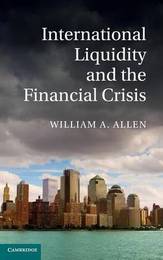
|
International Liquidity and the Financial Crisis
Hardback
Main Details
| Title |
International Liquidity and the Financial Crisis
|
| Authors and Contributors |
By (author) William A. Allen
|
| Physical Properties |
| Format:Hardback | | Pages:270 | | Dimensions(mm): Height 229,Width 152 |
|
| Category/Genre | Macroeconomics |
|---|
| ISBN/Barcode |
9781107030046
|
| Classifications | Dewey:339 |
|---|
| Audience | | Professional & Vocational | |
|---|
| Illustrations |
49 Tables, black and white; 36 Line drawings, unspecified
|
|
Publishing Details |
| Publisher |
Cambridge University Press
|
| Imprint |
Cambridge University Press
|
| Publication Date |
3 January 2013 |
| Publication Country |
United Kingdom
|
Description
In the ongoing financial crisis, policy makers have for the most part appeared to be reactive, formulating emergency solutions as events unfold. However, in contrast to their performance during the Great Depression, central banks around the world, led by the Federal Reserve, acted decisively following the collapse of Lehman Brothers and provided huge injections of liquidity into the financial markets, thereby preventing a far worse outcome. International Liquidity and the Financial Crisis compares the 2008 crisis with the disaster of 1931 and explores the similarities and differences. It considers the lasting effects of the crisis on international liquidity, the possibilities for an international lender of last resort, and the enlargement of the International Monetary Fund after the crisis. It shows that there is no clear demarcation between monetary and macro-prudential policies, and discusses how central banks need to adapt to a new environment in which global liquidity is much scarcer.
Author Biography
William A. Allen worked in the Bank of England from 1972 to 2004, where he was Head of the Money Market Operations Division, Head of the Foreign Exchange Division and Director for Europe. Since 2004 he has been an honorary senior visiting fellow of Cass Business School in London and has published widely on central banking and international finance. He is a specialist adviser to the House of Commons Treasury Committee and a consultant to the International Monetary Fund.
Reviews'The financial crisis that began in 2007 is a terrifying event, comparable only with the Great Depression between the world wars. Few expected it. Its effects spread almost everywhere. But it could have been so much worse. Allen's powerful new book moves from where, how and why it began, to describe and analyse the numerous things that central banks and governments around the world did to try to contain it. This volume is a well documented, highly readable must-read for everyone interested in the largely untold story of how it was that official reactions would help to prevent a really nasty crisis turning into an absolute disaster.' Peter Sinclair, University of Birmingham 'Shortage of liquidity can destroy a bank within hours; shortage of capital leads to a slow death. Yet in recent years regulators and academics have concentrated their attention on bank capital and almost ignored liquidity. In this book, Bill Allen returns to the tradition of the great writers on banking, Thornton and Bagehot, and analyzes what liquidity is, how it matters, and how neglect of it contributed to the recent crisis. This is a good and important book which manages to be both timely and of enduring worth.' Geoffrey Wood, Emeritus Professor, University of Buckingham and Emeritus Professor, Cass Business School, City University, London 'Bill Allen has written an outstanding, lucid account of the financial crisis and international liquidity flows. He shows how central banks responded to the crisis and makes a telling comparison with the last big international financial crisis in the 1930s.' Forrest Capie, Emeritus Professor, Cass Business School, City University, London 'Bill Allen has written a very clear account of the interaction between the withdrawal of liquidity from wholesale financial markets in 2007/8/9 and the unfolding of the crisis. He attributes the relative success, compared to 1931, of the steps taken to counteract the 2008/9 crisis to the willingness of Central Banks to expand their balance sheets, with particular emphasis on the Fed's willingness to extend dollar swaps to other countries. Ben Bernanke will find this a pleasure to read; so will you, and so did I, perhaps particularly, the nice short chapter (5) on changes, under pressure, to Central Bank theories and practice.' Charles Goodhart, Emeritus Professor, London School of Economics and Political Science 'This excellent book should be required reading for all central-bank governors will remain a valuable resource for economists and financial historians for many years to come.' Nicholas Crafts, The Business Economist
|